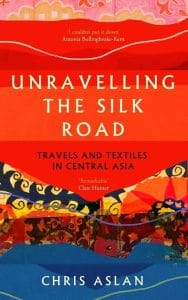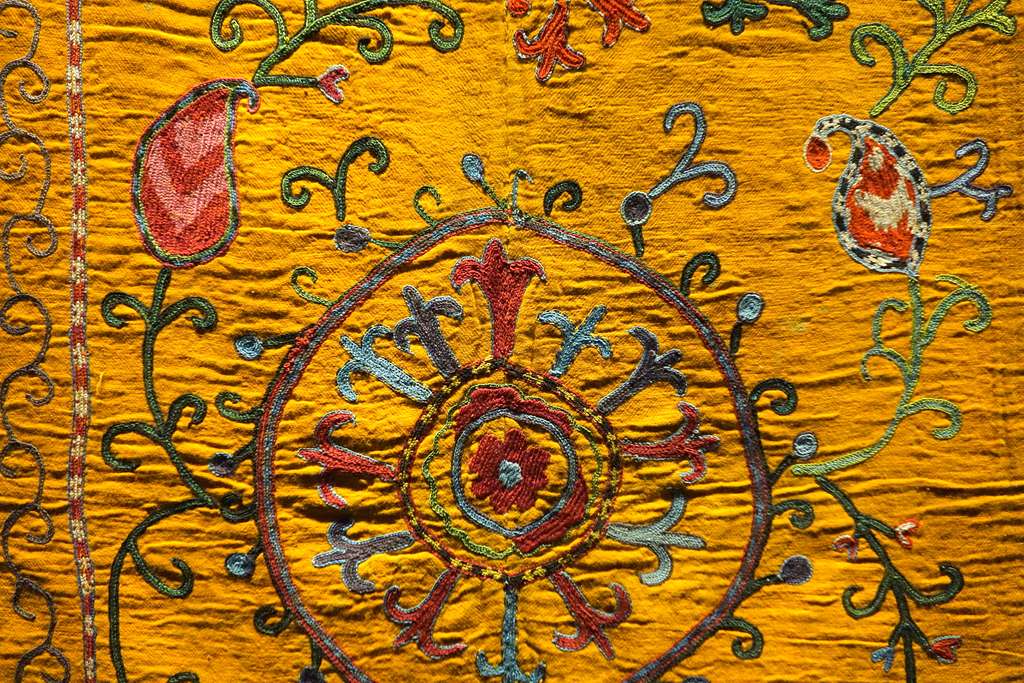Ankara-born Chris Aslan spent seven years living in Khiva, an old Silk Road town in what is now Uzbekistan, where he founded a silk carpet workshop. Expelled in 2005 during a purge of foreign NGOs, he then spent three years in Khorog, a town on the Tajikistan-Afghanistan border. Told by the authorities that perhaps he’d better leave there as well, he had a spell in Kyrgyzstan. In each place, Aslan clearly intends to “help”, whether by attempting to provide livelihoods at a time of chronic unemployment in Uzbekistan, help yak herders commercialise their animals’ down (competitive with cashmere, it seems) or to establish a school for carving walnut wood.
His most recent book Unravelling the Silk Road is nominally not about that, but rather to extend the concept of the iconic “Silk Road” to include a “Wool Road” and a “Cotton Road”. However, of the two elements in the subtitle “Travels and Textiles in Central Asia”, the book is in fact more about the former than the latter.

The case that the other two textiles are in some just as important as silk is compelling. Wool came first and was a crucial material that allowed, among other things, the expansion of Indo-Europeans across the steppe all the way to Tarim basin in what is now China. The “Cotton Road” runs more North-South, from India up through Central Asia into Russia. This is less obviously (or even metaphorically) a “road”, but more a framing mechanism for discussion of some of the economic and political disasters of the Soviet and post-Soviet Central Asia.
However, the skeleton of the book is Aslan’s own time and travels in the region: he is very much a hands-on participant, and a great deal of the book is informed by his on-the-ground experience, accompanied by the historical backgrounders necessary to to put both travels and textiles in context.
Alson writes with almost a journalist’s eye for description and dialogue. For those with little exposure to the region, this is a very easy read. He has real affection for the region and its people; he sees the decline in nomadism as very sad and fears that he may have experienced just about the last of it. He clearly knows his stuff when it comes to textiles; the discussion of fabrics, weaving, dying, embroidery and the like are descriptive and informative.
Structurally, however, the book sits somewhat uneasily between the two stools of travel-writing and serious history. By using the various textiles rather than the chronological travels as the framework, the book returns to places and events already covered. Aslan’s historical digressions (Roman-era phallic mosaics in Leptus Magna, the Great Game, the evil eye and Pliny the Elder’s comments, Marxism). while informative, can on occasion range rather far from the subject immediately at hand, and some of the details seem a bit open to question, as when he refers to people normally known as (proto-)Indo-Europeans or perhaps the Yamnaya as “proto-Celts” or writes that the (ethnically Chinese Muslim) Dungan spoke an “an ancient dialect of Mandarin”.
Filled with anecdotes and personal observation, Unravelling the Silk Road is perhaps better shelved under travel-writing than, say, history. Like all good travel-writing, it is both informed and informative. However, like any book which tracks the author’s own experience, it tends to focus on those aspects of the subject that the author came into direct contact with. Its purported central thesis therefore is, nor could have been, as fully developed as it might have been in a more research-driven book. There is perhaps another book waiting to be written about Central Asia, its history and present, as seen through its textiles.


You must be logged in to post a comment.